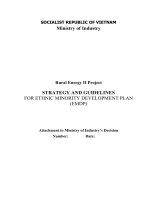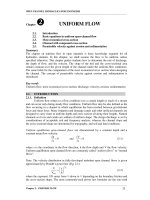Tài liệu STRATEGY AND GUIDELINES FOR ETHNIC MINORITY DEVELOPMENT PLAN (EMDP) doc
Bạn đang xem bản rút gọn của tài liệu. Xem và tải ngay bản đầy đủ của tài liệu tại đây (212.64 KB, 19 trang )
SOCIALIST REPUBLIC OF VIETNAM
Ministry of Industry
Rural Energy II Project
STRATEGY AND GUIDELINES
FOR ETHNIC MINORITY DEVELOPMENT PLAN
(EMDP)
Attachment to Ministry of Industry’s Decision
Number: Date:
VN-Rural Energy Project 2: Strategy for Ethnic Minorities February, 2004
January, 2004
2
VN-Rural Energy Project 2: Strategy for Ethnic Minorities February, 2004
Table of content
1. Introduction...........................................................................................................................................................4
2. Ethnic Minorities in Viet Nam..............................................................................................................................5
3. THE STARTEGY.................................................................................................................................................7
4. Guidelines for Ethnic Minority Development Plan (EMPD)................................................................................7
5. Screening...............................................................................................................................................................8
6. Social Impact Assessment.....................................................................................................................................8
7. Ethnic Minority Development Plan.......................................................................................................................9
8. Implementation Arrangement................................................................................................................................9
9. Monitoring.............................................................................................................................................................9
10. Schedule............................................................................................................................................................10
11. Budget...............................................................................................................................................................10
12. Reporting/Documentation.................................................................................................................................10
Annex 1: Preliminary Screening of Ethnic Minorities...........................................................................................12
Annex 2: Social Impact Assessment......................................................................................................................13
A. Demographic Social Cultural and Economic Situation........................................................................13
11. Tenure systems of main ethnic groups: briefly describe land ownership and tenure systems (e.g.,
communal ownership, private ownership, gender differences in ownership, etc.)......................................14
B. Social, Cultural and Economic Impact..................................................................................................14
1. Potential positive impacts:.....................................................................................................................14
From Men:..............................................................................................................................................................15
Mitigation measures.........................................................................................................................................16
3
VN-Rural Energy Project 2: Strategy for Ethnic Minorities February, 2004
1. INTRODUCTION
1. The overall development objective of the VN-Rural Energy 2 Project is to improve
access to good quality, affordable electricity services to rural communities, in an efficient and
sustainable manner. This would be achieved through: (a) major upgrading and/or expansion of
rural power networks in about 1200 communes; (b) conversion of current ad-hoc rural
electricity management systems to local distribution utilities (LDUs), as legal entities
recognized under Vietnamese law, to improve management of power distribution in rural areas,
improve financial sustainability, and better enable future mobilization of funds; and (c) capacity
building assistance for the LDUs, provincial authorities involved in planning and regulation of
rural electrification, participating regional power companies, and national authorities. The
proposed project would improve access to energy to about 1 million households in Vietnam,
including many living in some of the poorest communes. The project also will enable supply of
large increases in electric power for expanding productive uses in rural areas, alleviating a
major constraint to local economic growth.
2. The project will include two Project Components:
• Rural Distribution System Development Component. This will include most of the IDA
financing, and is the main thrust of the project. It will be implemented province-by-
province, with a medium-voltage (MV) sub-component of about $70 million (about $55
million IDA funds and $15 million in counterpart funds) implemented by EVN’s
subsidiaries, and a low-voltage (LV) sub-component of about $228 million (about $163
million IDA funds and about $65 million in counterpart funds) implemented by
Provincial Peoples’ Committees (PPCs), with technical support and assistance from
EVN’s subsidiaries.
• Capacity Building Component. This component will include both IDA financing of
about $1.5 million, and an associated GEF project, with about $5.25 million in GEF
grant financing. This component will support capacity building for the local distribution
utilities, especially in system and company management, and for local and national
authorities on rural electrification regulation, policy development and planning.
The project will be prepared and implemented in phases. The phase 1A (to be prepared for the
appraisal) includes six (06) provinces namely: Vinh Phuc, Ha Tinh, Quang Ngai, Phu Yen, Ca
Mau and Ben Tre with the total of 360 communes. The phase 1B will include six (06) provinces
namely Nghe An, Yen Bai, Tay Ninh, Dong Thap, Quang Tri and Thua Thien Hue with the
total of 210 communes. The phase II will include eighteen (18) provinces namely Lao Cai, Cao
Bang, Lai Chau, Hoa Binh, Phu Tho, Thai Nguyen, Bac Giang, Ha Tay, Hai Duong, Hung Yen,
Thai Binh, Ha Nam, Nam Dinh, Thanh Hoa, Ninh Thuan, Can Tho, Quang Binh and Binh Dinh
with total of 558 communes.
3. For the subprojects to be located in the areas of Ethnic Minorities, every special effort
will be made through design, construction measures and construction schedules to reduce
adverse impacts on Ethnic Minorities. For the rehabilitation/expansion of the Medium Voltage
system, the adverse impacts would be on individuals and at low-intensity, most of impacts on
land of Ethnic Minorities will be temporary, some families of Ethnic Minorities will be
permanently acquired land for constructing of towers/poles and substations. Therefore, the
project subcomponents would not cause any culturally specific impact on the affected ethnic
4
VN-Rural Energy Project 2: Strategy for Ethnic Minorities February, 2004
minority households and the nature of impacts does not result in community-wide socio-
economic effects.
4. Sub-projects may be implemented in Provinces, Districts and Communes where ethnic
minority people are present as part of the population. In line with the World Bank’s Operational
Directive on Indigenous Peoples (OD 4.20), an Ethnic Minority Development Plan (EMDPs)
will be developed for areas that have ethnic minority households according to this strategy for
ethnic minorities. Ethnic minorities are social groups with a social and cultural identity distinct
from the dominant society that may make them vulnerable to being disadvantaged in the
development process. According to OD 4.20 ethnic minorities can be identified in particular
geographical areas by the presence in varying degrees of the following characteristics:
(a) A close attachment to ancestral territories and to the natural resources in these
areas;
(b) Self-identification and identification by others as members of a distinct cultural
group;
(c) An indigenous language, often different from the national language;
(d) Presence of customary social and political institutions; and
(e) Primarily subsistence-oriented production.
5. The purpose of this strategy is to ensure that the development process foster full respect
for dignity, human rights, and cultural uniqueness of Ethnic Minority People. More
specifically, the objective of this strategy is to ensure that EM do not suffer adverse effects
during the development process and that they will receive culturally compatible social and
economic benefits.
2. ETHNIC MINORITIES IN VIET NAM
6. Ethnic Vietnamese, known as Kinh, with about 85 Percent of total population, dominate
the political, economic, and social affairs of the socialist Republic of Viet Nam. There are
officially another 53 ethnic groups in Viet Nam who constitute the category of ethnic
minorities. Most of ethnic minorities population live in the uplands. Population of ethnic
minority groups range from over a million to only a few hundred. The only ethnic minority
groups who live mainly in the lowlands are Hoa (Chinese), Cham and Khmer.
7. Ethnic minorities in Viet Nam are diverse origin. A majority (39) as well as Kinh speak
languages in the Austro-Asiatic language family. But others speak Austronesian and Sino-
Tibetan languages. They differ greatly in ways of livelihood, social organization. Some have
had relationship with Kinh society for a long time, while others have lived in relative isolation
until recent decades. Some groups have lived in their present locations for many centuries,
while others have migrated into their present location within the past hundred years.
8. In the past fifty years, many ethnic minorities communities have shifted residence
because of war, governmental settlement programs, or a depleted resource base. As many as
five million Kinh have been relocated from the lowlands into upland areas. The biophysical,
5
VN-Rural Energy Project 2: Strategy for Ethnic Minorities February, 2004
social, and political context of the lives for most ethnic minorities has changed drastically in the
past fifty years.
9. Equality right of ethnic people was stipulated clearly in the Vietnam Law. Article 5 in
the Vietnam Constitution (1992) stipulated as follows:
The Socialist Republic of Vietnam is an united nation having many nationalities. The State
implements a policy of equality and unity and supports the cultures of all nationalities and
prohibits discrimination and separation. Each nationality has the right to use its own language
and characters to preserve their culture and to improve its own traditions and customs. The
State carries out a policy to develop thoroughly and gradually improve the quality of life of
ethnic minorities in Vietnam physically and culturally.
10. Since 1968, the Government has promulgated sedenterization policy for ethnic groups,
reducing migration trends of the ethnic people. One of the most important policies on relation
with ethnic groups is the Government Guidance No.525/TTG on 2/11/1993 regarding in detail
on implementation guiding of development in high land areas and ethnic areas with the main
following points:
• Develop infrastructure especially transportation road system and fresh water supplying;
• Gradual increase food security;
• Consolidate of education system; adjust education program based on the characteristics of
provinces; create favor conditions and support the non-formal education programs and
develop the internal economy.
11. Ethnic minorities in Vietnam have enjoyed better legal and political status than minority
groups have in many other countries in the region, or around the world. They have received
many benefits as a result of government policies. They have received preferential treatment in
college admission processes. Cooking oil, kerosene, and iodized salt have been provided to
them at heavily subsidized rates. The government, foreign donor agencies, and many NGOs
have organized numerous development and special assistance programs that targeted ethnic
minorities. Very large sums of money have been invested with the intention of helping the
uplands in general and ethnic minorities in particular to “catch up” with lowland areas.
12. While many—probably most—ethnic minority households have better material
standards of living today than they did ten or fifteen years ago, they are still not catching up
with the rest of the country economically. Indeed, they are in many ways falling further behind.
There are many reasons for the poverty of ethnic minority groups in Vietnam. The peoples are
struggling to adapt to severe stresses placed upon them from population pressure, resource
depletion, and cultural dislocation resulting from decades of externally imposed change.
Development of the region must concentrate on promoting the process of adaptive change,
recognizing that it must be accomplished by the people themselves, and that they will inevitably
have to devise many different ways of doing it.
6
VN-Rural Energy Project 2: Strategy for Ethnic Minorities February, 2004
3. THE STARTEGY
13. The main objective of the ethnic minority framework is to ensure that the development
process foster full respect for their dignity, human rights, cultural uniqueness and that ethnic
minorities do not suffer adverse impacts during the development process and they will receive
culturally-compatible social and economic benefits. The Bank's OD 4.20 on Indigenous
Peoples indicates that the strategy for addressing the issues pertaining to indigenous peoples
must be based on the informed participation of the indigenous people themselves. Thus,
identifying local preferences through direct consultation, incorporation of indigenous
knowledge into project approaches, and appropriate early use of experienced specialists are core
activities for any project that affects Ethnic Minority Peoples and their rights to natural and
economic resources.
14. The State of Viet Nam has the policy of not discriminating against Ethnic Minority
Peoples as showed by the presence of Ethnic People Council in the National Assembly and
Ethnic People Committee in the Government . Article 94 in the Constitution, 1992 states that
the Ethnic People Committee has the right to submit proposals, plans or related issues of
indigenous peoples to the Assembly, monitor, control the implementation of national policies,
development programs on various areas such as, education, health care, etc. Article 5 of the
Constitution also indicates that ethnic minority people could use their own languages to reserve
its cultural distinctions. In the Government of Viet Nam, directly under the supervision of the
Prime Minister is the Committee of Ethnic Minorities (which is equivalent to a Ministry).
Development programs are supervised by this Committee, such as the poverty reduction
Program 135 according to the degree No, 135/1998/QD-TTg of the Prime Minister to promote
the construction of small-scale infrastructure in poor ethnic minority villages.
15. According to the Government of Viet Nam, ethnic minorities have the following
characteristics:
− An intimate understanding and long stay in the territory, land or area of their
ancestors closed attachment to the natural resources;
− Self-identification and recognized by neighboring members by their distinctive
culture
− A language different from the national language
− A long traditional social and institutional system
− A self-provided production system.
16. This strategy will applied to all of the sub-projects of Rural Energy Project no.2 where
applicable.
4. GUIDELINES FOR ETHNIC MINORITY DEVELOPMENT PLAN (EMPD)
17. The guidelines seek to ensure that ethnic minorities are well informed, consulted and
mobilized to participate in the sub-projects to be supported by Rural Energy No. 2 Project.
Their participation can either provide them benefits with more certainty, or protect them from
7









